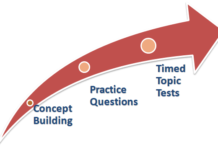This is a clear trend indication if you look at the scoring patterns at various percentiles. A student solving questions with 100% accuracy requires only 23-25 attempts to get a top 400 All India Rank in the test (99.8+ percentile). However, if your accuracy drops by just 5% to 95%, your attempts need to go up to 30+ to ensure the choice of skipping questions. A student solving between 23-25 questions at 100 percent accuracy, can skip 9-11 questions same score.
What this means, is that if your accuracy is just 5% off the 100% accuracy level, you would almost completely lose out of 34, while at 95% accuracy since the same percentile would require 30+ attempts, such a student would practically have no leeway to leave questions.
Hence, the key learning for you while preparing is to focus on improving your accuracy as well as the belief in your process of solving. This is especially true while preparing for the QA section.
While solving a QA question, you should be able to know that if your process is correct then your answer would also be correct. The need to check the answer to a QA question is something that is only required for minds weak in Quantitative Aptitude. This is where an under-prepared aspirant loses out to
Unfortunately, most students I see are more interested in seeing the answer to the question as soon as they solve the same.
This is a habit I would strongly discourage you from. The ideal preparation process for you should be:
(a) solve the questions,
(b) review your process and tell yourself, if your process is correct, so is your answer”, and
C) only check your answer after you have reviewed your process.
This is important, because when you are solving a QA question inside CAT, you would not have the cushion to “look’at the answer.
The only thing you have is the question and the process you use in solving the same. Your mind should be able to tell whether the answer you have got is correct or not. This is a key difference in solving questions in practise and solving them under exam pressure.
Hence, developing more confidence in your QA problem-solving processes becomes a key ingredient and objective of your preparation process for this section.





